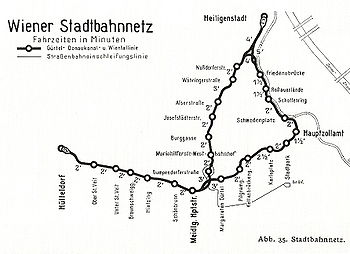
Back Виенска градска железница Bulgarian Wiener Stadtbahn German Urbfervojo de Vieno Esperanto Viini linnaraudtee Estonian Stadtbahn (Bécs) Hungarian Wiener Stadtbahn ID シュタットバーン (ウィーン) Japanese Wiedeńska kolej miejska Polish Венский штадтбан Russian Wiens stadsbana Swedish
This article needs additional citations for verification. (February 2024) |

The Vienna Stadtbahn (German: Wiener Stadtbahn) was a rail-based public transportation system operated under this name from 1898 until 1989. Today, the Vienna U-Bahn lines U4 and U6 and the Vienna S-Bahn (commuter rail) run on its former lines.
In 1894, the architect Otto Wagner was hired as the artistic director for the Vienna Stadtbahn project.[1] The Stadtbahn is one of Vienna's better-known examples of early Art Nouveau architecture. Its most famous buildings are the two former station entrances on Karlsplatz, now used as a café and a museum respectively, and the Hofpavillon, a station built specifically for Emperor Franz Joseph, located at the eastern end of Hietzing station. Other preserved historical stations are the elevated stations along the Gürtel and in some of the suburbs.
The use of the term Stadtbahn in the line's name derives from the 19th century usage of the term to simply mean a railway in an urban area, in a similar way to the naming of the roughly contemporaneous Berlin Stadtbahn. It is not related to the usage of the term stadtbahn in post-World War II Germany to mean light rail lines upgraded from street tramways. The use of tram type vehicles on much of the Vienna Stadtbahn after 1925 is entirely coincidental, and happened long after the line got its name.
- ^ Haiko, Peter (1992). Vienna 1850–1930: Architecture. Rizzoli. p. 106. ISBN 084781324X.
© MMXXIII Rich X Search. We shall prevail. All rights reserved. Rich X Search